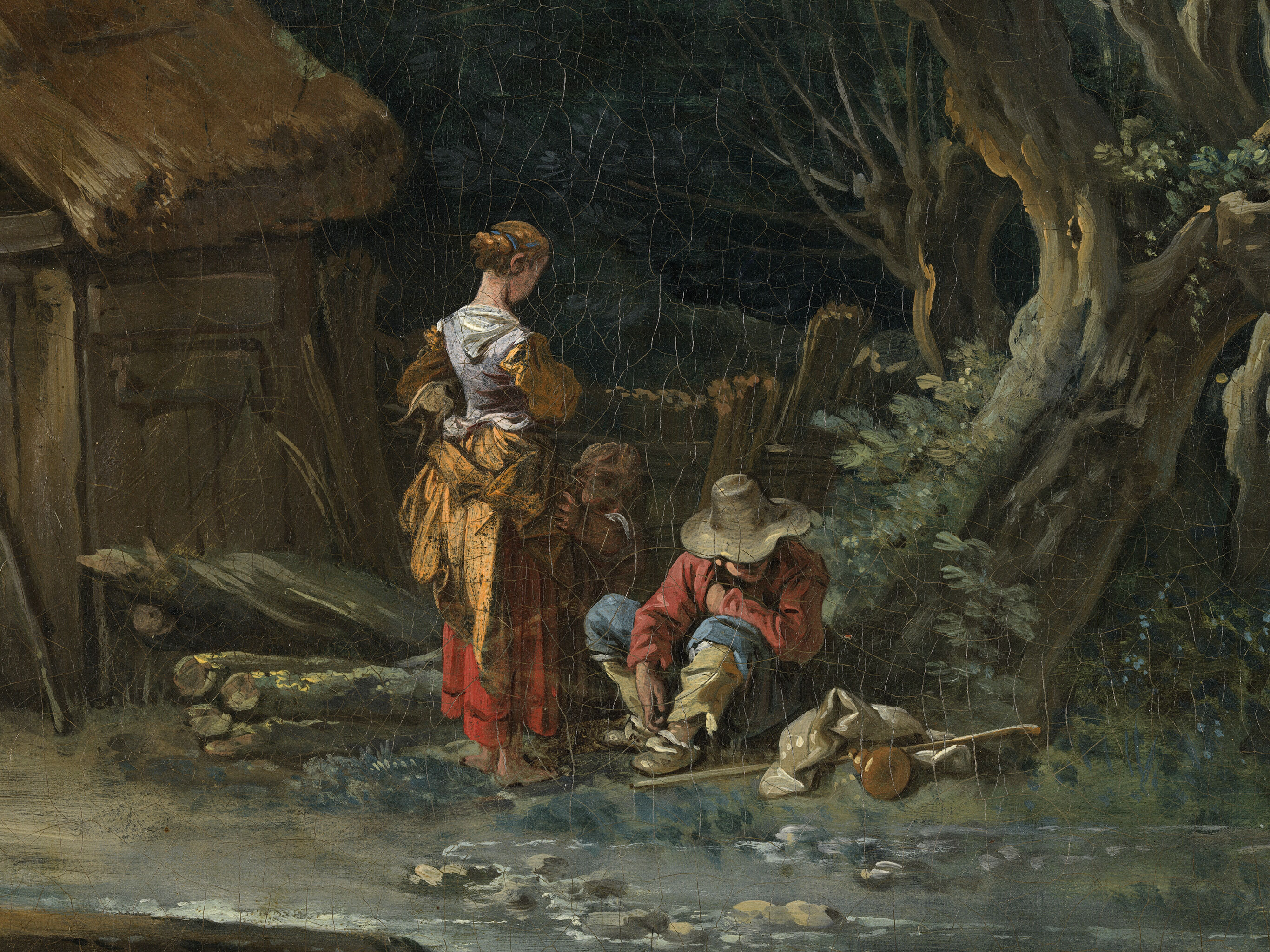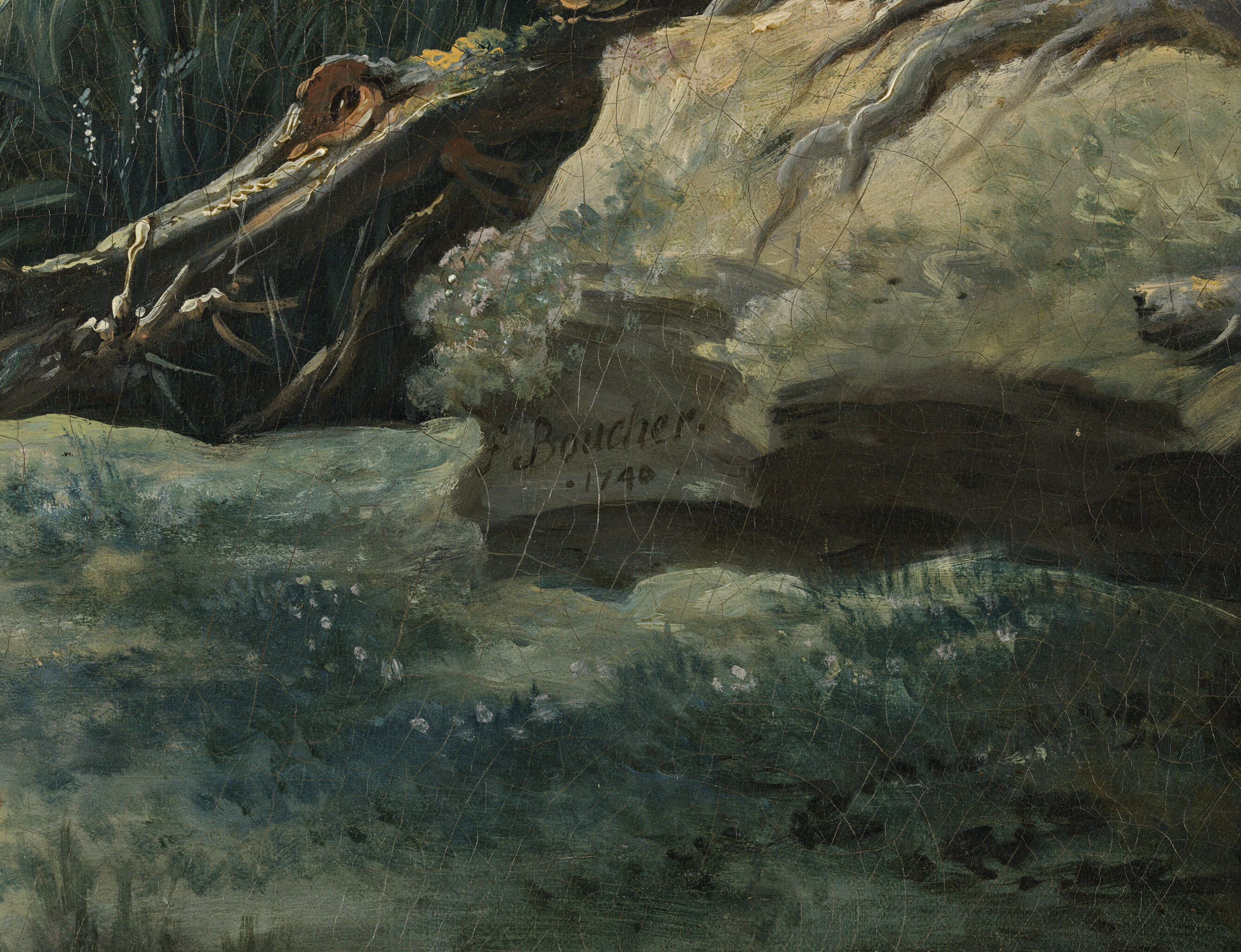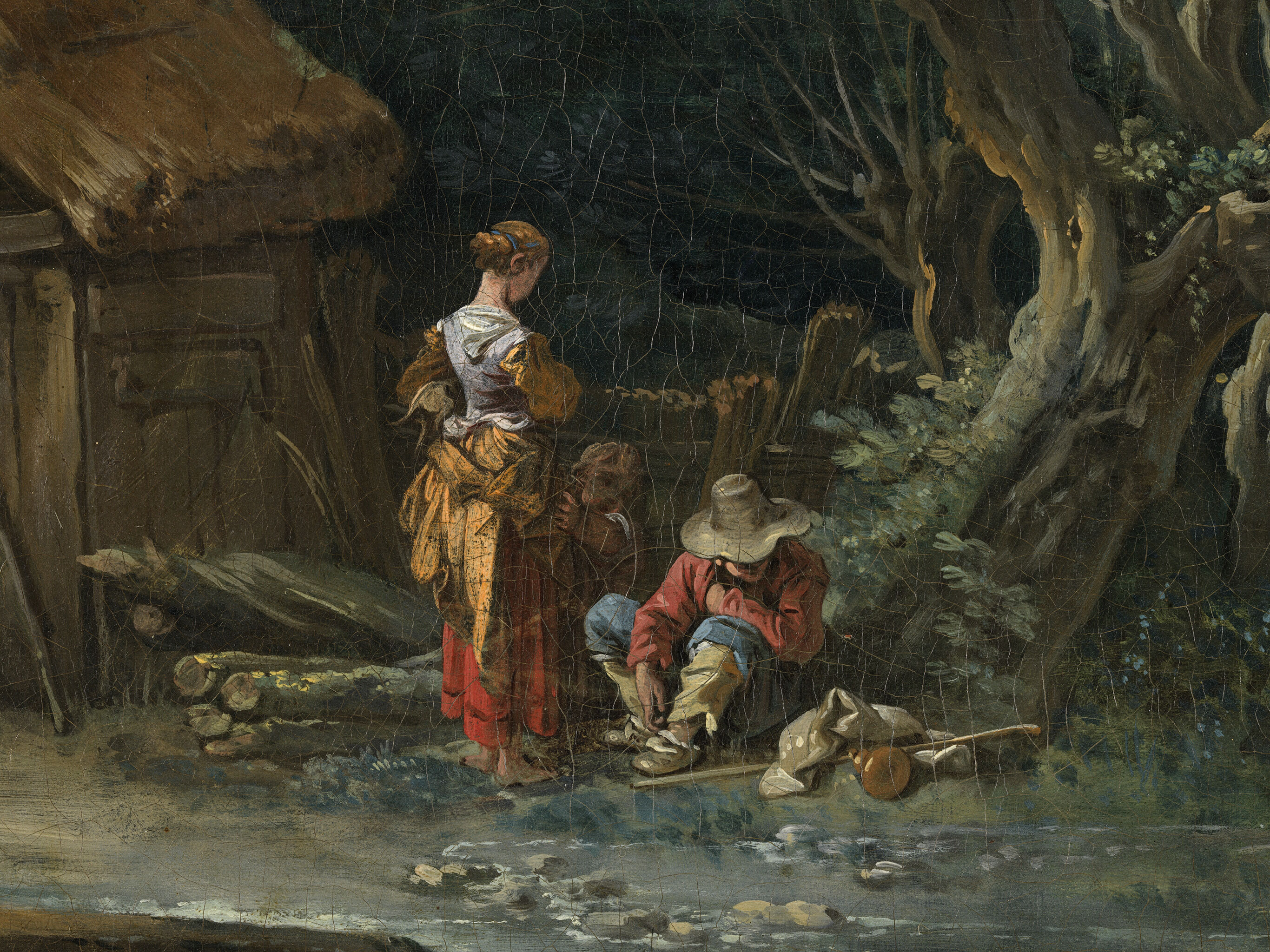![]()
François Boucher, Landscape with a Water Mill, 1740
| Artist | François Boucher, French, 1703–70 |
| Title | Landscape with a Water Mill |
| Object Date | 1740 |
| Alternate and Variant Titles | Un Païsage [sic] où l’on voit un Moulin; Un paysage, des fabriques, un moulin à eau, plusieurs figures et des animaux sur des plans différens [sic]; Vue des environs de Beauvais; Landscape in the Environs of Beauvais, and Souvenir of Italy; Paysage aux Environs de Beauvais et Souvenir d’Italie |
| Medium | Oil on canvas |
| Dimensions (Unframed) | 51 5/16 x 64 1/4 in. (130.3 x 163.2 cm) |
| Signature | Signed and dated lower right (on rock): F Boucher./.1740 |
| Credit Line | The Nelson-Atkins Museum of Art. Purchase: William Rockhill Nelson Trust, 59-1 |
Catalogue Entry
Citation
Chicago:
Richard Rand, “François Boucher, Landscape with a Water Mill, 1740,” catalogue entry in French Paintings and Pastels, 1600–1945: The Collections of The Nelson-Atkins Museum of Art, ed. Aimee Marcereau DeGalan (Kansas City: The Nelson-Atkins Museum of Art, 2021), https://doi.org/10.37764/78973.5.304.5407.
MLA:
Rand, Richard. “François Boucher, Landscape with a Water Mill, 1740,” catalogue entry. French Paintings and Pastels, 1600–1945: The Collections of The Nelson-Atkins Museum of Art, edited by Aimee Marcereau DeGalan, Nelson-Atkins Museum of Art, 2021. doi: 10.37764/78973.5.304.5407.
Landscape with a Water Mill and its pendantpendant: One of two paintings conceived as a pair and intended to be displayed togther., The Forest, in the Musée
du Louvre, Paris (Fig. 1),1Alexandre Ananoff and Daniel Wildenstein, François Boucher (Lausanne: Bibliothèque des Arts, 1976), nos. 175 and 176, pp. 1:19, 294–95. constitute the most ambitious landscape
paintings of Boucher’s career. Trained as a history painter—that is, an
artist who depicts figural subjects drawn from the stories of the Bible,
classical mythology, and literature—Boucher would have as a matter of
course relegated landscape to a subsidiary role in his oeuvre, even
though nature in its various guises frequently appeared in the
backgrounds of his compositions. This is especially true of one of his
favorite subject categories, pastoralspastorals: A genre of painting that portrays rural life, especially the lives of shepherds, in an idealizing way. Such works represent the courtier’s or city-dweller’s dream of escape., as well as the large-scale
designs he made for the tapestry works at Beauvais, in which landscape
settings play a significant part in the expressive meaning but the
figures still dominate. Boucher first demonstrated his interest in
painting and drawing the landscape for its own sake during a trip to
Italy in 1728–1731, and the genre continued to appeal to him throughout
his long career. It is therefore perhaps significant that in his two
known depictions of a painter at work, Boucher placed a landscape on the easel and represented the artist conjuring the scene from his
imagination with the aid of sketches (Fig. 2).2See Ananoff and Wildenstein, François Boucher, no. 424. Indeed, this was the
common practice for landscape painters in Boucher’s day, who invariably
painted landscapes in the studio based on their imagination and with the
aid of drawings and sketches they made outdoors.
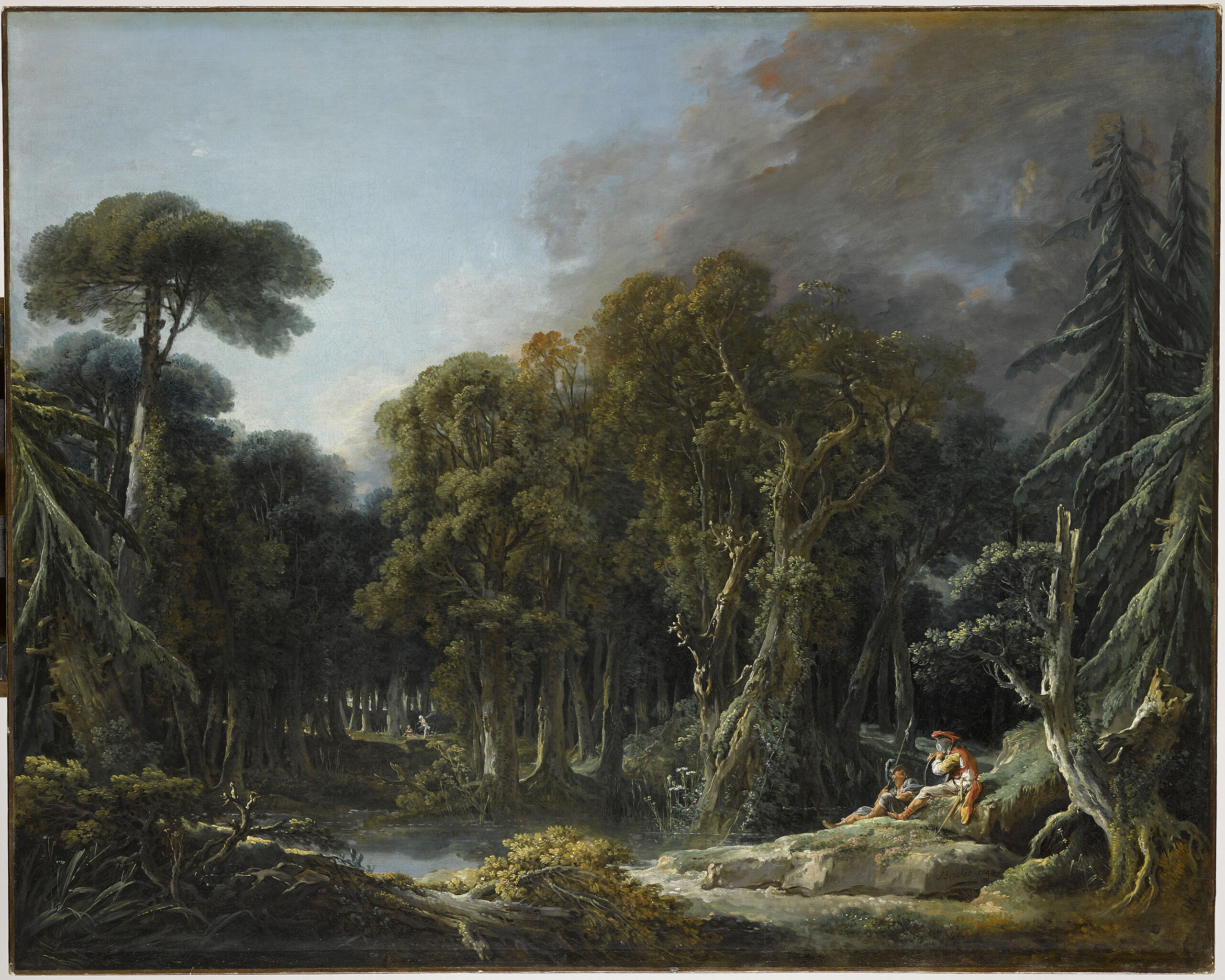 Fig. 1. François Boucher, The Forest, 1740, oil on canvas, 51 3/16 x 64 3/16 in. (130 x 163 cm), Musée du Louvre, Paris
Fig. 1. François Boucher, The Forest, 1740, oil on canvas, 51 3/16 x 64 3/16 in. (130 x 163 cm), Musée du Louvre, Paris
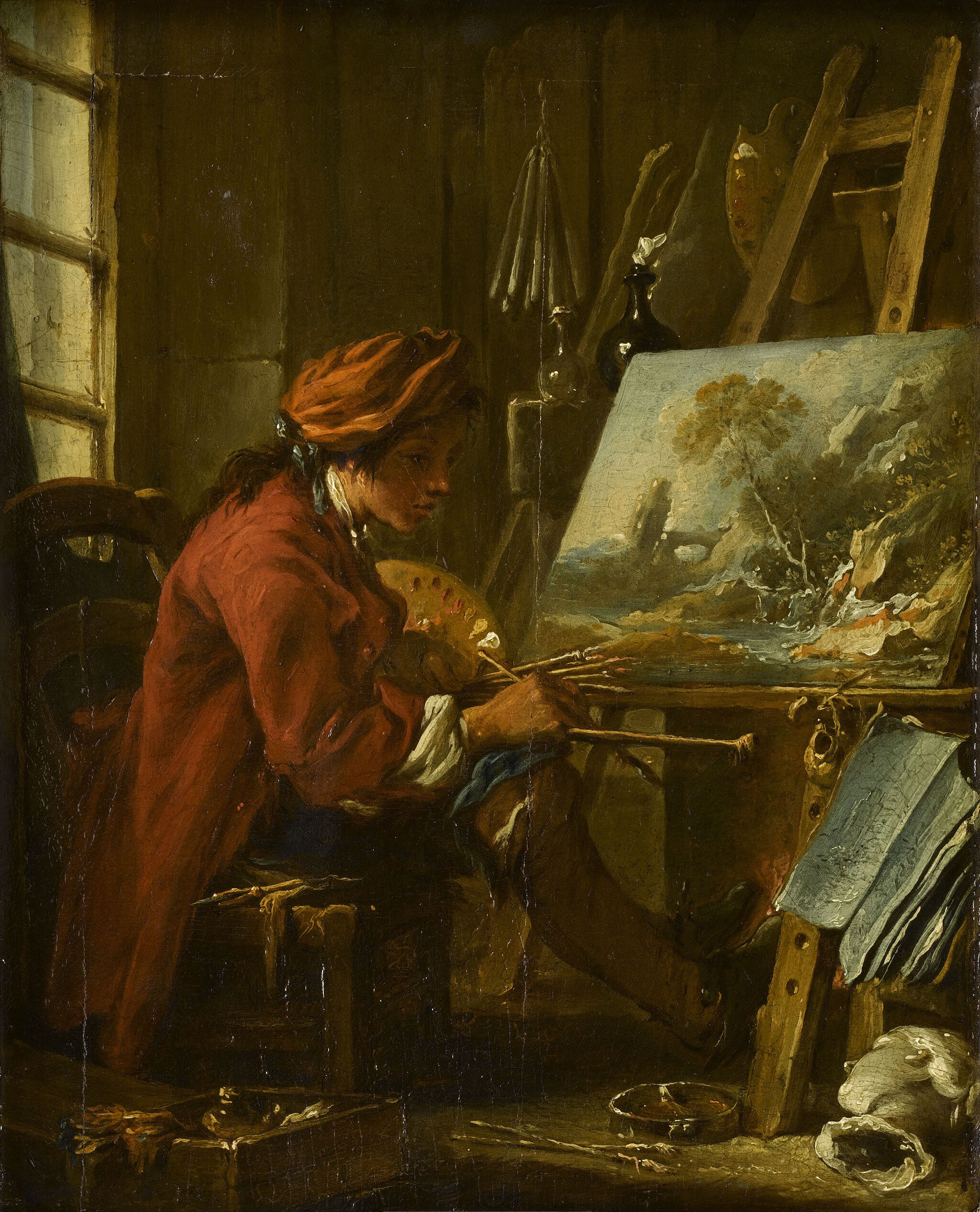 Fig. 2. François Boucher, The Painter in His Atelier, ca. 1730–35, oil on panel, 10 5/8 x 8 11/16 in. (27 x 22 cm), Musée du Louvre, Paris
Fig. 2. François Boucher, The Painter in His Atelier, ca. 1730–35, oil on panel, 10 5/8 x 8 11/16 in. (27 x 22 cm), Musée du Louvre, Paris
Prior to 1740 (the date of the Kansas City picture and its pendant),
Boucher’s landscapes usually represent sites he had seen in Italy,
such as the picturesque hill town of Tivoli or the Campo Vaccino in
Rome.3See, for example, Ananoff and Wildenstein, François Boucher, nos. 48 and 101. Boucher’s earliest known view of a French landscape, The Mill of Quiquengrogne at Charenton, is dated 1739, in Ananoff and Wildenstein, François Boucher, no. 167. He executed these paintings—which sometimes exist in several
versions, not all of them entirely by Boucher’s hand—in Paris based on
drawings he had made during his Italian sojourn.4See the discussion by Alastair Laing in Laing et al., François Boucher: 1703–1770, exh. cat. (New York: Metropolitan Museum of Art, 1986), 130–32. Only later did
Boucher paint what might be identified as recognizably French
landscapes. Landscape with a Water Mill, with its pleasing tumbledown
mill, meandering river, and luxuriant trees framing the scene, appears
at first glance to reflect the countryside around Paris, such as
Charenton or Arceuil, where Boucher occasionally went to sketch. Indeed,
he followed the lead of the painter Jean Baptiste Oudry (1686–1755),
who frequented the overgrown gardens of the château of the prince de
Guise in Arcueil to make drawings. This is not to suggest that the site
depicted in the Kansas City picture represents in any direct way the
gardens at the château in Arcueil or the landscape
around Charenton, famous for its picturesque water mill (though one of a
very different design), only that the character of the foreground
buildings and the trees seems to be French rather than Italian. A more
likely inspiration for the setting could be the environs of Beauvais,
north of Paris, the seat of the famous tapestry manufactory for which
Boucher began providing designs in 1736 under the direction of Oudry,
its director since 1734.5Laing, François Boucher, 19. As Alastair Laing has pointed out, the
water mill in the Kansas City painting is identical to the one in a
painting exhibited by Boucher at the term of 1743 that was engraved
with the title Seconde vue de Beauvais (Fig. 3).6Laing, François Boucher, 186. The whereabouts of the painting are unknown, according to Ananoff and Wildenstein, François Boucher, no. 255; at the Salon, it was described under no. 21 as “Autre représentant un Païsage, où paroît un Moulin à eau; et une Femme donnant à manger à des Poules” (“Another representing a Landscape, where a Water Mill appears; and a Woman feeding Chickens”: i.e., without reference to Beauvais). For the engraving by Jacques Philippe Le Bas, see Pierrette Jean-Richard, L’Œuvre gravé de François Boucher dans la Collection Edmond de Rothschild (Paris: Éditions des musées nationaux, 1978), no. 1341.
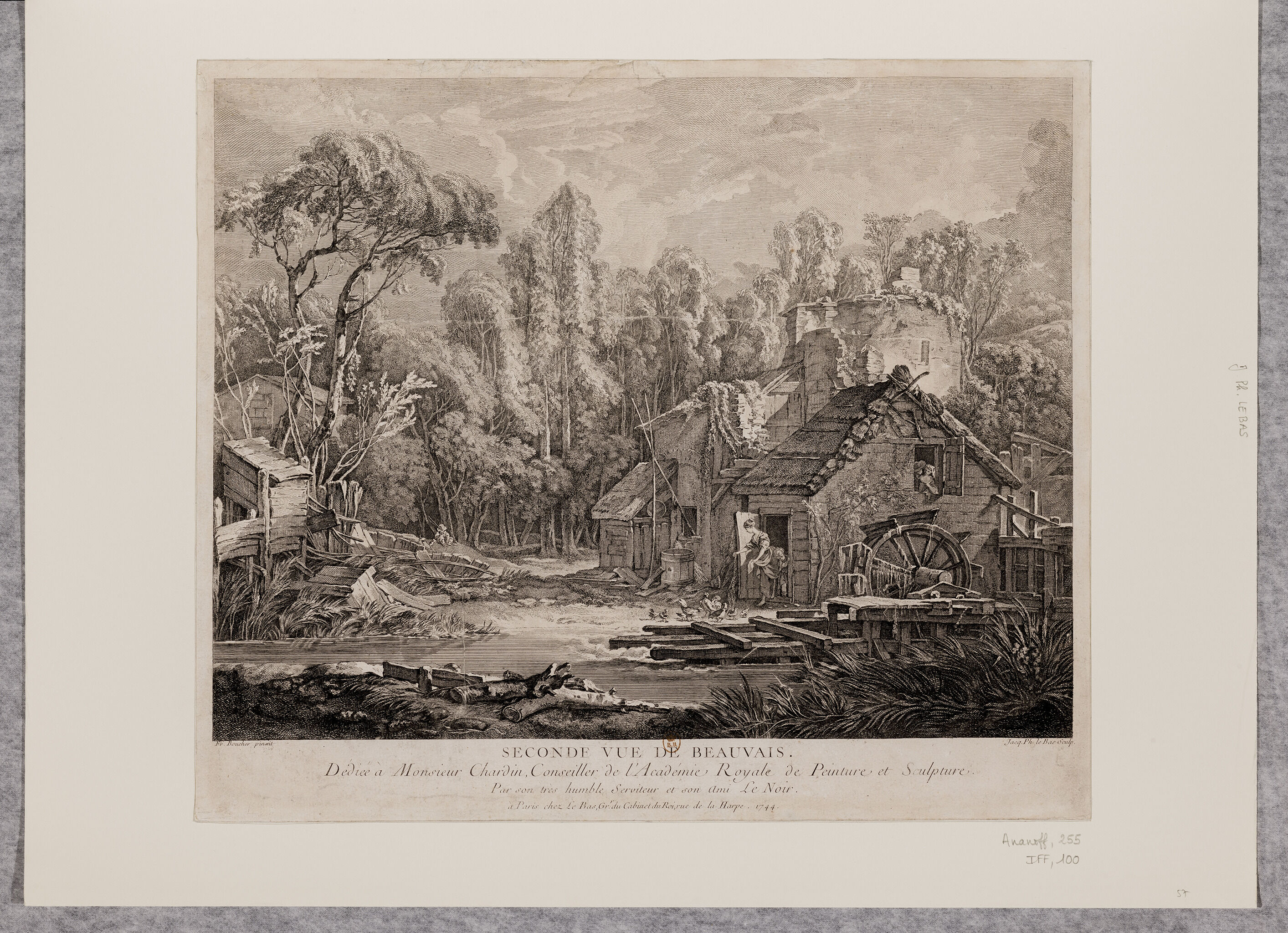
Given this, it is all the more striking that Boucher included in the
background of the scene an ancient ruin, circular and colonnaded, that
closely resembles the so-called Temple of the Sybil in Tivoli, a hill
town east of Rome. This structure appears in several of Boucher’s
earlier landscape paintings and drawings, but always in its proper
context, seen overlooking the gorge at the edge of the town. Its
inclusion here, as a backdrop to what must have been understood as a
decidedly French site in the foreground, underscores the fanciful aspect
of the scene, creating an idealized amalgam of the Roman Campagna, the
ruined temple (a wistful evocation of classical antiquity), and the
rustic French countryside, with its tumbledown mill and dallying
milkmaids. Boucher emphasized this disconnect between near and far by
immersing the mill and its surrounding forest in deep shadow while
illuminating the distant temple with bright sunlight. The combination is
less convincing than the similar conceit produced by the foremost French
landscapist of the day, Claude Joseph Vernet (1714–1789), whose two
paintings in Kansas City ( F84-66/1 and F84-66/2 )
similarly draw together the ancient and modern worlds. Vernet’s keen
sense of observation and naturalistic style make his attempts far more
persuasive to the viewer. By contrast, Boucher’s rococo idiom—the
sweeping compositional forms, the acidic green palette, the creamy paint
texture—fixes the scene firmly in the realm of fantasy, giving the
viewer no illusion that it might actually exist. The figures gathered
around the mill add to the sense of unreality: we can make out one of
the artist’s typical young country women, here barefoot and somewhat
bedraggled, a child grasping her skirts, who is
attempting to engage a seated man, undoubtedly a weary traveler, based
on the evidence of his boots and of the staff and gourd he has laid on
the ground (Fig. 4). A second woman peers out of the open door just to the right
of water wheel at the extreme left of the picture. These figure types
populate numerous paintings by Boucher.
In the painting’s pendant The Forest, a more unified landscape of dense woods fills the entire width of the composition, the stately rows of tree trunks marking a series of planes receding into the distance (see Fig. 1). In contrast to Landscape with a Mill, here we are far from any habitation, deep in a forest populated only by a pair of soldiers in the right foreground and a male and female couple at the left beyond the water, just visible among the trees in the middle distance. The inspiration here is less the French countryside or the Italian Campagna than German or Dutch landscapes of the previous century—one is reminded in particular of the woodland scenes of Jacob van Ruisdael (Dutch, 1628/1629–1682). That said, the dying tree stripped of its bark at the right and the picturesque soldiers resting near it call to mind the landscapes of Salvator Rosa (1615–1673), an Italian painter whose works Boucher could have seen in Rome.7A comparable Ruisdael, though not one available to Boucher, is Forest Scene, ca. 1655, oil on canvas, 41 9/16 x 48 9/16 in. (105.5 x 123.4 cm), National Gallery of Art, Washington, DC; see Arthur K. Wheelock Jr., “Jacob van Ruisdael/Forest Scene/c. 1655,” Dutch Paintings of the Seventeenth Century, NGA Online Editions, https://purl.org/nga/collection/artobject/1219 (accessed December 18, 2017). A comparable Rosa is Rocky Landscape with a Hunter and Soldiers, ca. 1670, oil on canvas, 55 7/8 x 75 5/8 in. (142 x 192 cm), Musée du Louvre, Paris, inv. 586. This aesthetic eclecticism, and the mannered self-referential character of rococo painting in general, was typical of Boucher’s work. Looking at these two large decorative canvases, their first owners would have responded positively to the subtle references to the great traditions of landscape painting practice in both northern Europe and Italy, as well as to the pictures’ sheer visual appeal. According to Laing, Boucher probably painted the pictures for Marin de la Haye (1684–1753), a wealthy fermier généralfermier général: French for “general farmer.” A private citizen who collects taxes on behalf of the French monarchy. in Paris who had family ties to some of Boucher’s most important patrons.8Laing, François Boucher, 186–87. After the SalonSalon, the: Exhibitions organized by the French Royal Academy of Painting and Sculpture (Académie Royale de Peinture et de Sculpture) and its successor the Academy of Fine Arts (Académie des Beaux Arts), which took place in Paris from 1667 onward. of 1740, the paintings were first recorded in 1778 in the posthumous sale in Paris of de la Haye’s widow, where they were described as “richly detailed and interesting in composition, painted with a masterly touch and accurate coloration, but pleasing and good.“9“Ces deux tableaux . . . sont riches & intéressans [sic] de composition, d’un faire savant & d’un coloris clair, mais agréable & bon”; Pierre Rémy, Catalogue de Tableaux Originaux De Jacques Bassan, Gaspre Dughet, Philippe Wouwermans, Lenain, Baptiste Monoyer, Desportes, François Boucher, Charles Natoire; MM. Pierre, La Grenée, et autres Maîtres de diverses Écoles; Figures et grouppes [sic] de bronze et de marbre, Tables et Consoles de marbre, Glaces, etc., après le décès de Madame veuve de M. De La Haye, Fermier-Général (Paris: Musier, December 1, 1778), lot 30, pp. 11–12. The pair appeared four years later in the sale of the collection of the wife of the painter Nicolas Lancret (1690-1743), but it is doubtful that she actually owned them, as her collection had been inherited from her husband, who had died in 1743. It is more likely, as Laing points out, that they were offered as an extra lot in Madame Lancret’s sale, inserted there by art connoisseur and auctioneer Pierre Rémy (1715–1797), who purchased them from the de La Haye sale in 1778.10Laing, François Boucher, 186–87.
Notes
-
Alexandre Ananoff and Daniel Wildenstein, François Boucher (Lausanne: Bibliothèque des Arts, 1976), nos. 175 and 176, pp. 1:19, 294–95.
-
See Ananoff and Wildenstein, François Boucher, no. 424, p. 2: 116.
-
See, for example, Ananoff and Wildenstein, François Boucher, no. 48, p. 1: 185, and no. 101, p. 1: 228-29. Boucher’s earliest known view of a French landscape, The Mill of Quiquengrogne at Charenton, is dated 1739, in Ananoff and Wildenstein, François Boucher, no. 167, p. 1: 288.
-
See the discussion by Alastair Laing in Laing et al., François Boucher: 1703–1770, exh. cat. (New York: Metropolitan Museum of Art, 1986), 130–32.
-
Laing, François Boucher, 19.
-
Laing, François Boucher, 186. The whereabouts of the painting are unknown, according to Ananoff and Wildenstein, François Boucher, no. 255, p. 1: 371; at the Salon, it was described under no. 21 as “Autre représentant un Païsage, où paroît un Moulin à eau; et une Femme donnant à manger à des Poules” (“Another representing a Landscape, where a Water Mill appears; and a Woman feeding Chickens”; i.e., without reference to Beauvais). For the engraving by Jacques Philippe Le Bas, see Pierrette Jean-Richard, L’Œuvre gravé de François Boucher dans la Collection Edmond de Rothschild (Paris: Éditions des musées nationaux, 1978), no. 1341, p. 323.
-
A comparable Ruisdael, though not one available to Boucher, is Forest Scene, ca. 1655, oil on canvas, 41 9/16 x 48 9/16 in. (105.5 x 123.4 cm), National Gallery of Art, Washington, DC; see Arthur K. Wheelock Jr., “Jacob van Ruisdael/Forest Scene/c. 1655,” Dutch Paintings of the Seventeenth Century, NGA Online Editions, https://purl.org/nga/collection/artobject/1219 (accessed December 18, 2017). A comparable Rosa is Rocky Landscape with a Hunter and Soldiers, ca. 1670, oil on canvas, 55 7/8 x 75 5/8 in. (142 x 192 cm), Musée du Louvre, Paris, inv. 586.
-
Laing, François Boucher, 186–87.
-
“Ces deux tableaux . . . sont riches & intéressans [sic] de composition, d’un faire savant & d’un coloris clair, mais agréable & bon”; Pierre Rémy, Catalogue de Tableaux Originaux De Jacques Bassan, Gaspre Dughet, Philippe Wouwermans, Lenain, Baptiste Monoyer, Desportes, François Boucher, Charles Natoire; MM. Pierre, La Grenée, et autres Maîtres de diverses Écoles; Figures et grouppes [sic] de bronze et de marbre, Tables et Consoles de marbre, Glaces, etc., après le décès de Madame veuve de M. De La Haye, Fermier-Général (Paris: Musier, December 1, 1778), lot 30, pp. 11–12.
-
Laing, François Boucher, 186–87.
Technical Entry
Citation
Chicago:
Mary Schafer, “François Boucher, Landscape with a Water Mill, 1740,” technical entry in French Paintings and Pastels, 1600–1945: The Collections of The Nelson-Atkins Museum of Art, ed. Aimee Marcereau DeGalan (Kansas City: The Nelson-Atkins Museum of Art, 2021), https://doi.org/10.37764/78973.5.304.2088.
MLA:
Schafer, Mary. “François Boucher, Landscape with a Water Mill, 1740,” technical entry. French Paintings and Pastels, 1600–1945: The Collections of The Nelson-Atkins Museum of Art, edited by Aimee Marcereau DeGalan, The Nelson-Atkins Museum of Art, 2021. doi: 10.37764/78973.5.304.2088.
During a treatment that predates the 1959 acquisition, Landscape with a Water Mill was glue-linedlining: A procedure used to reinforce a weakened canvas that involves adhering a second fabric support using adhesive, most often a glue-paste mixture, wax, or synthetic adhesive. and the stretcherstretcher: A wooden structure to which the painting’s canvas is attached. Unlike strainers, stretchers can be expanded slightly at the joints to improve canvas tension and avoid sagging due to humidity changes or aging. was replaced. Information about the original canvas is limited, as the tacking marginstacking margins: The outer edges of canvas that wrap around and are attached to the stretcher or strainer with tacks or staples. See also tacking edge. have been removed and the outermost edges are covered by brown paper and retouchingretouching: Paint application by a conservator or restorer to cover losses and unify the original composition. Retouching is an aspect of conservation treatment that is aesthetic in nature and that differs from more limited procedures undertaken solely to stabilize original material. Sometimes referred to as inpainting or retouch.. A faint cuspingcusping: A scalloped pattern along the canvas edges that relates to how the canvas was stretched. Primary cusping reveals where tacks secured the canvas to the support while the ground layer was applied. Secondary cusping can form when a pre-primed canvas is re-stretched by the artist prior to painting. pattern is evident on the left, right, and bottom edges, and the size of the painting is comparable to that of its pendant, The Forest (1740; Musée du Louvre), suggesting that the dimensions of the Nelson-Atkins painting have not been significantly altered. Microscopic examination indicates that the canvas was prepared with a double groundground layer: An opaque preparatory layer applied to the support, either commercially or by the artist, to prevent absorption of the paint into the canvas or panel. See also priming layer. consisting of a lower reddish-orange layer and an upper off-white layer. Above the ground, no underdrawingunderdrawing: A drawn or painted sketch beneath the paint layer. The underdrawing can be made from dry materials, such as graphite or charcoal, or wet materials, such as ink or paint. or painted sketch was detected using either infrared reflectography (IRR)infrared reflectography (IRR): A form of infrared imaging that exploits the behavior of painting materials at wavelengths beyond those accessible to infrared photography. These advantages sometimes include a continuing increase in the transparency of pigments beyond wavelengths accessible to infrared photography (i.e, beyond 1,000 nanometers), rendering underdrawing more clearly. The resulting image is called an infrared reflectogram. Devices that came into common use in the 1980s such as the infrared vidicon effectively revealed these features but suffered from lack of sharpness and uneven response. Vidicons continue to be used out to 2,200 nanometers but several newer pixelated detectors including indium gallium arsenide and indium antimonide array detectors offer improvements. All of these devices are optimally used with filters constraining their response to those parts of the infrared spectrum that reveal the most within the constraints of the palette used for a given painting. They can be used for transmitted light imaging as well as in reflection. or magnification.1The painting was examined using a Hamamatsu vidicon camera.
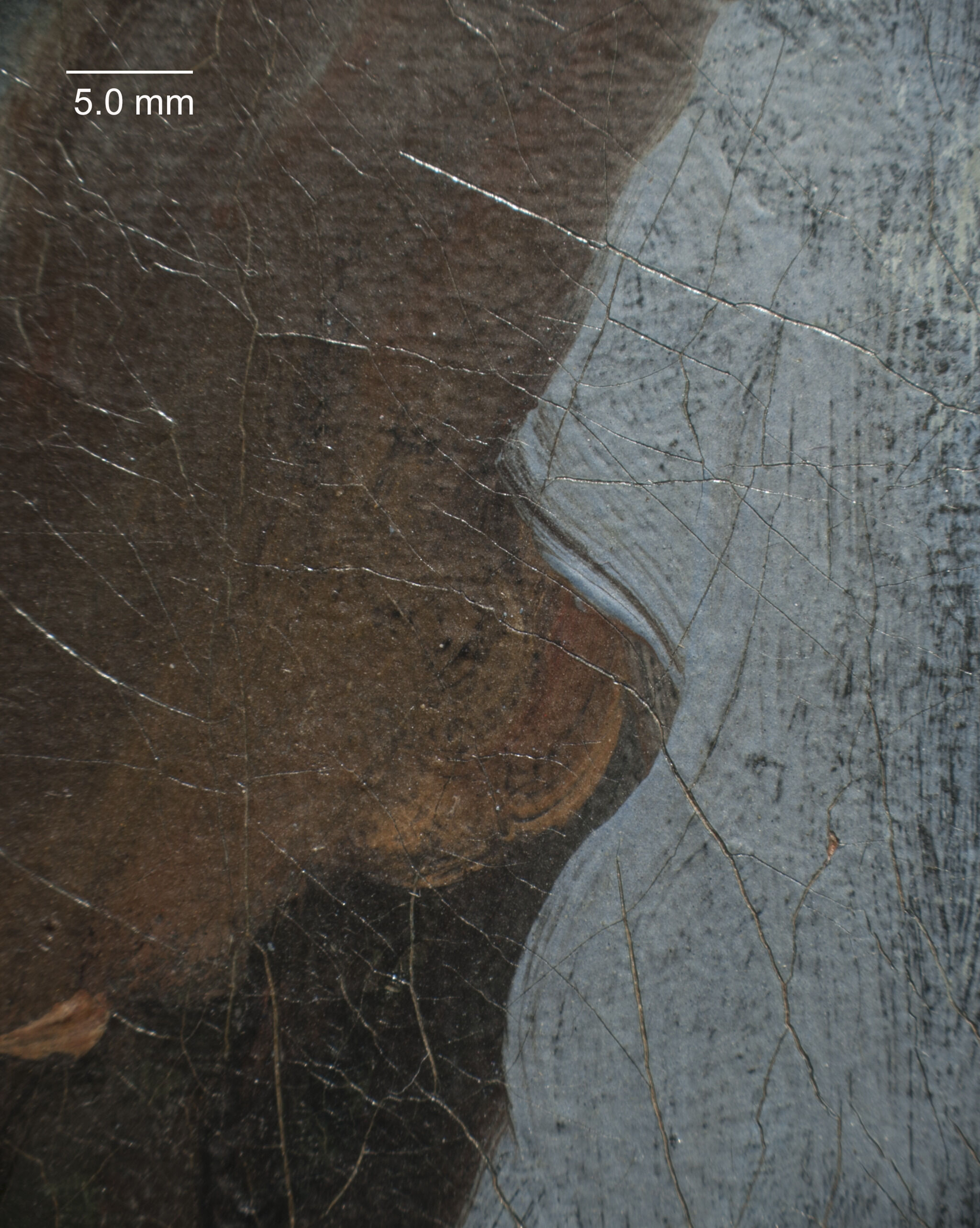 Fig. 5. Photomicrograph of Landscape with a Water Mill (1740) showing the blue paint of the sky covering the adjacent tree
Fig. 5. Photomicrograph of Landscape with a Water Mill (1740) showing the blue paint of the sky covering the adjacent tree
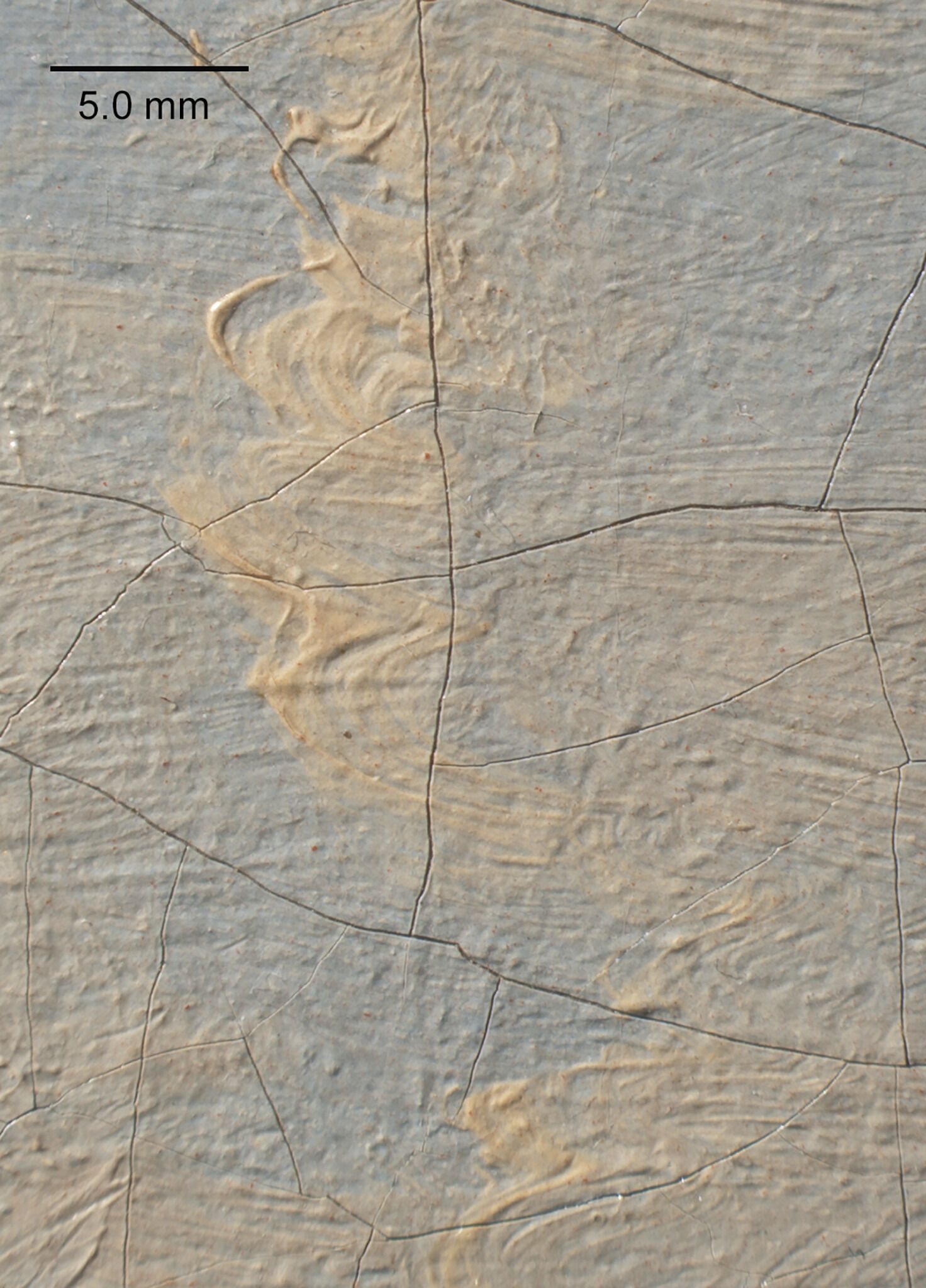 Fig. 6. Photomicrograph of the central clouds of Landscape with a Water Mill (1740)
Fig. 6. Photomicrograph of the central clouds of Landscape with a Water Mill (1740)
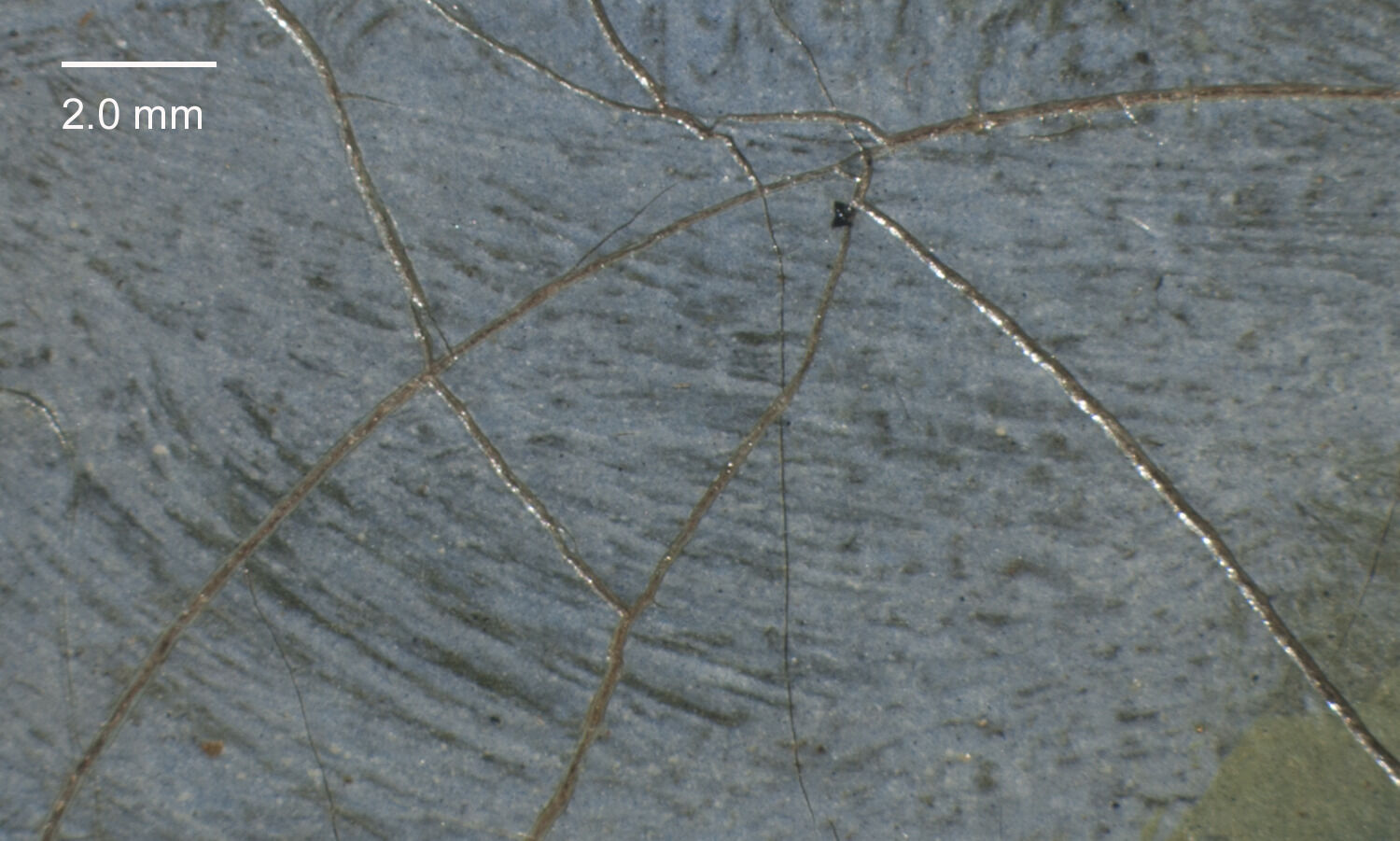 Fig. 8. Photomicrograph of Landscape with a Water Mill (1740) showing the green paint of the trees beneath the blue sky
Fig. 8. Photomicrograph of Landscape with a Water Mill (1740) showing the green paint of the trees beneath the blue sky
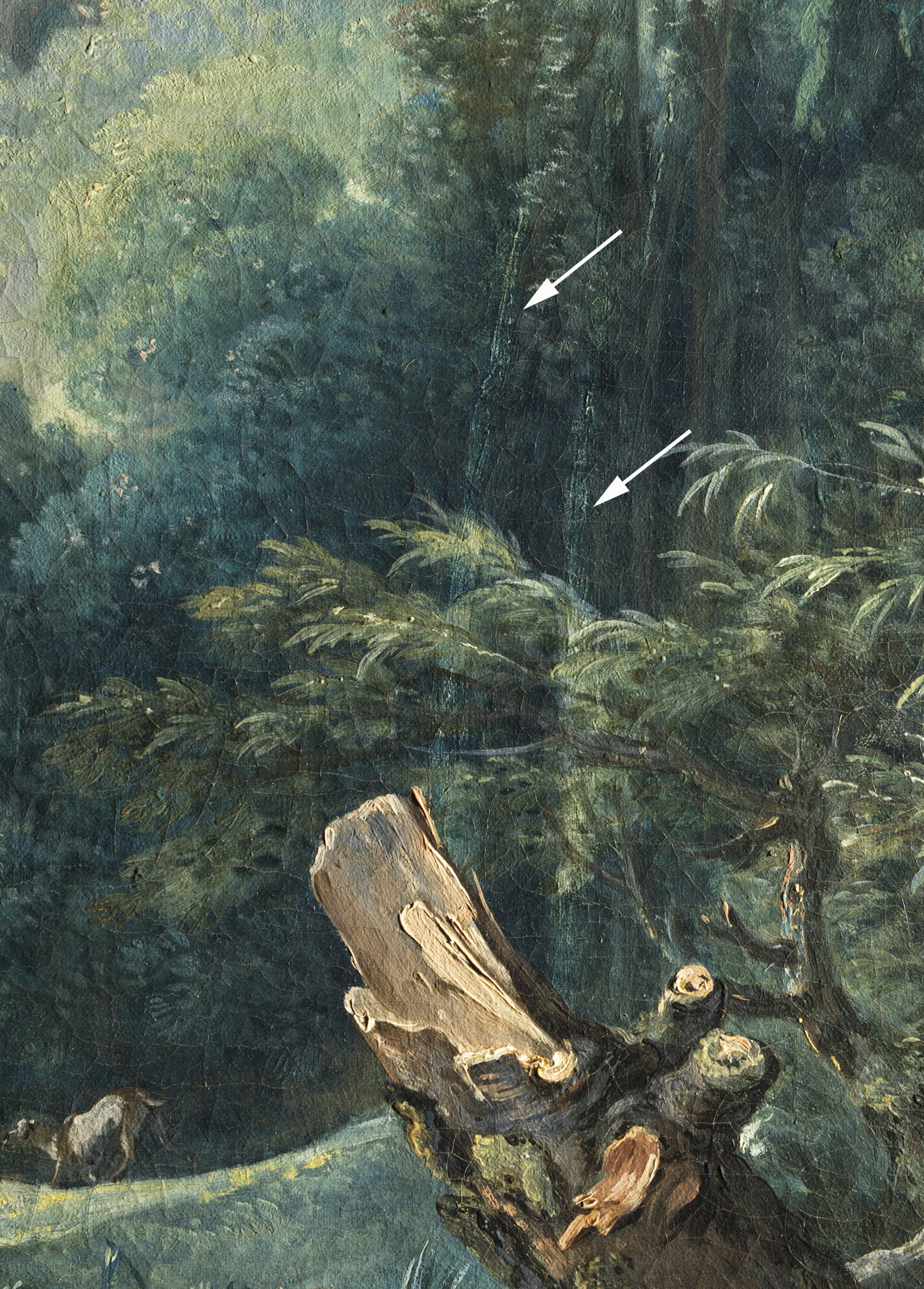 Fig. 9. Slightly raking light detail of Landscape with a Water Mill (1740) showing the pentimenti of two tree trunks
Fig. 9. Slightly raking light detail of Landscape with a Water Mill (1740) showing the pentimenti of two tree trunks
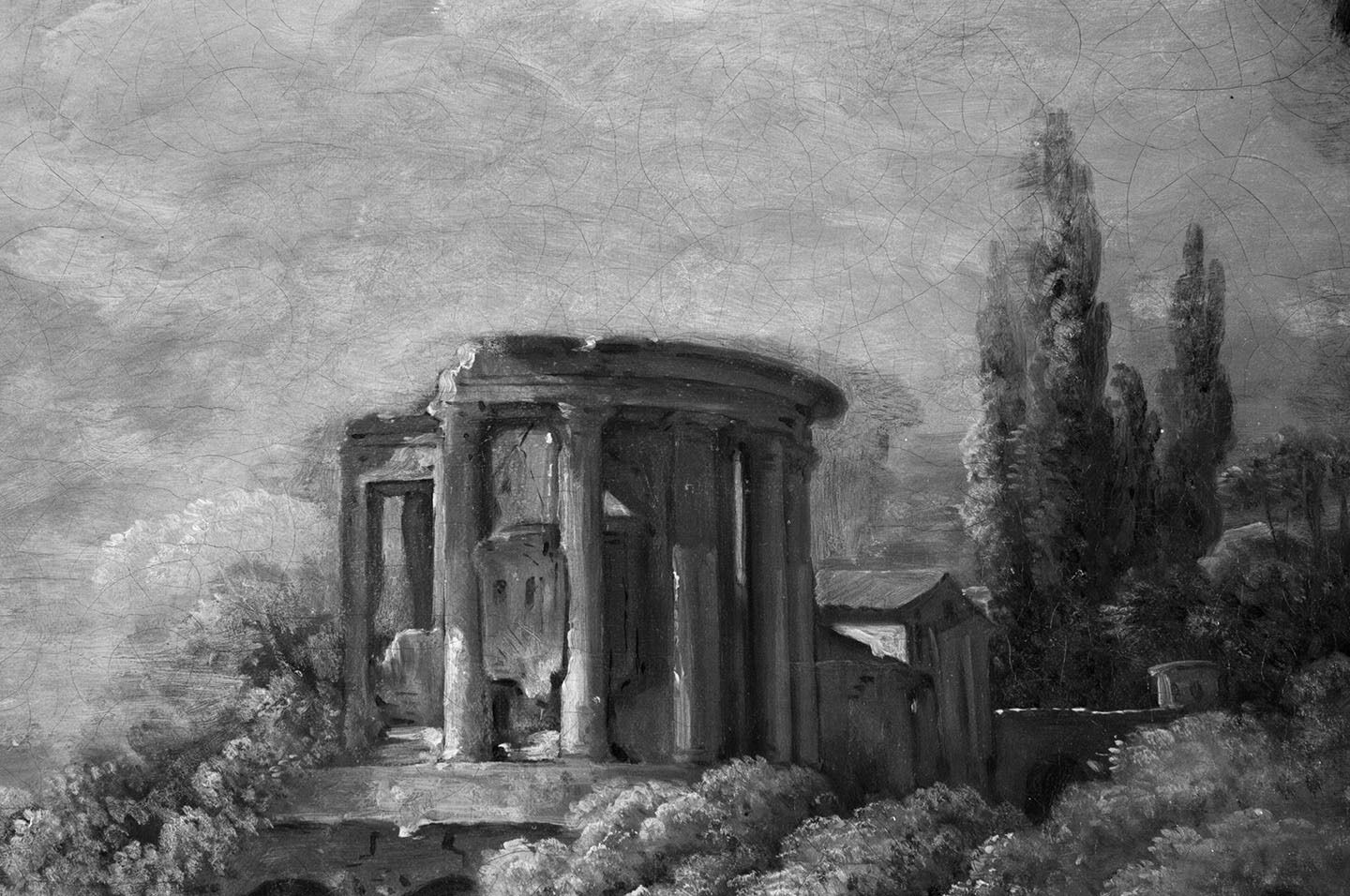 Fig. 10. Reflected infrared digital photograph of Landscape with a Water Mill (1740) showing the artist’s modifications to the ancient ruin in the distance
Fig. 10. Reflected infrared digital photograph of Landscape with a Water Mill (1740) showing the artist’s modifications to the ancient ruin in the distance
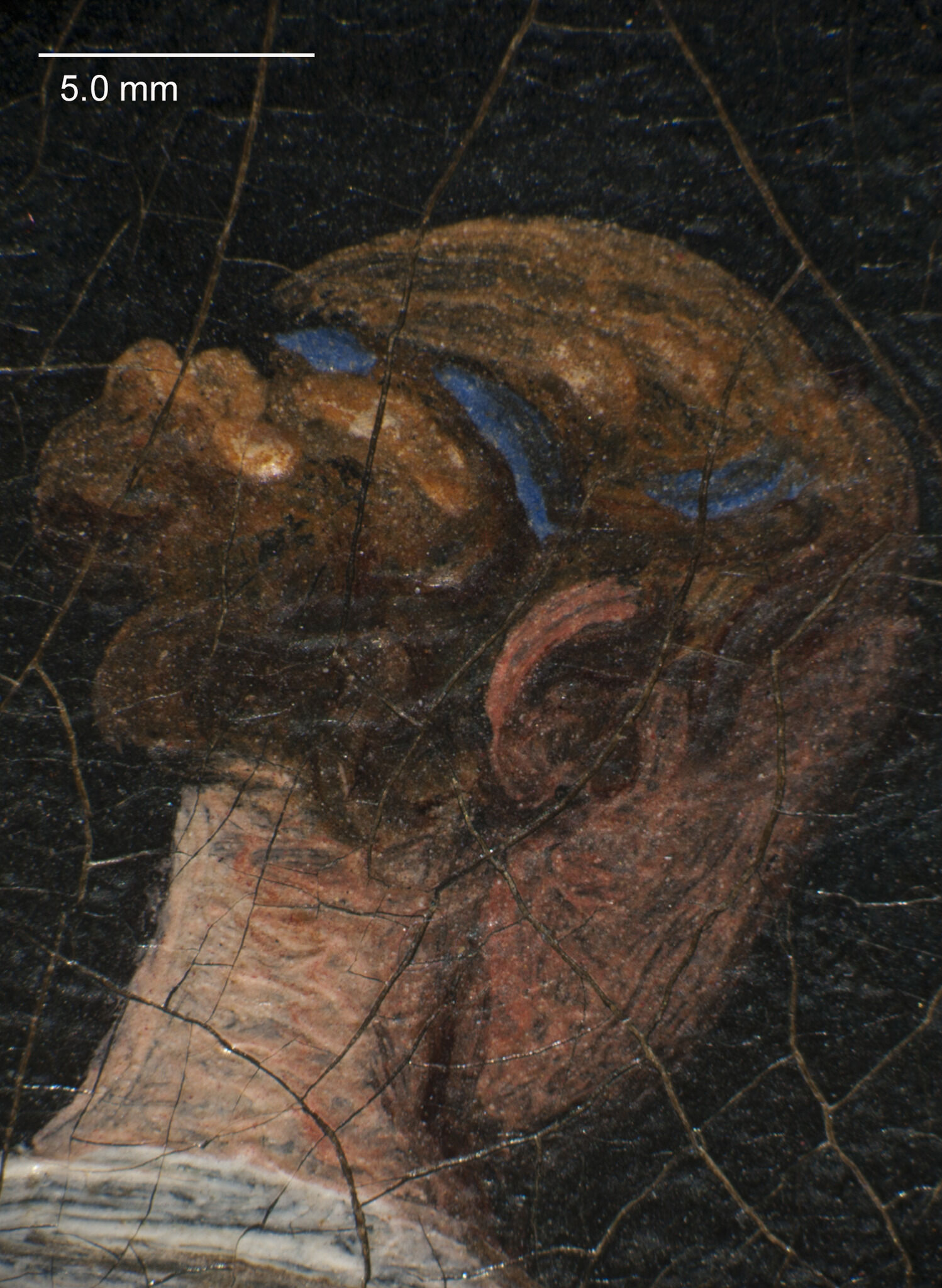 Fig. 11. Photomicrograph of the central female, Landscape with a Water Mill (1740)
Fig. 11. Photomicrograph of the central female, Landscape with a Water Mill (1740)
Considering its large format, the painting is well preserved. The lining canvas is weak and brittle, a condition issue that was first documented by conservation staff in 1958.2James Roth, October 28, 1958, examination report, NAMA conservation file, no. 59-1. A linear indentation on the face of the painting in the left sky relates to the stabilization of a horizontal split (26.7 centimeters) in the lining canvas. Canvas undulations are evident on the upper left and lower right edges. Impactimpact cracks: A characteristic crack pattern that forms after a blow to a painting. When these appear as circular, spiral, or spiderweb-like, they are sometimes called sigmoid cracks. and age cracksage cracks: The formation of cracks that occur due to a loss of elasticity in the paint film and priming as these materials age, combined with responses to environmental changes (i.e. expansion and contraction of the support). that expose the off-white ground are visually distracting in the darker passages of the landscape. There are a few signs of past overcleaning: the thinly painted, abraded branches at the top of the upper right tree and a disrupted dark glazeglaze: A transparent, oil or resin-rich paint application that influences the tonality of the underlying paint. on its trunk. A small amount of blanchingblanching: A whitish haze or discoloration that may indicate deterioration of a varnish layer or an alteration of the paint film caused by inappropriate cleaning. gives local sections of the foreground a whitish appearance. The synthetic varnish has become discolored and unsaturated over time, impacting the darker passages and details of the foreground. Discolored retouching is mainly present at the outermost edges with only a small amount scattered across the painting.
Notes
-
The painting was examined using a Hamamatsu vidicon camera.
-
James Roth, October 28, 1958, examination report, NAMA conservation file, no. 59-1.
Documentation
Citation
Chicago:
Meghan Gray, “François Boucher, Landscape with a Water Mill, 1740,” documentation in French Paintings and Pastels, 1600–1945: The Collections of The Nelson-Atkins Museum of Art, ed. Aimee Marcereau DeGalan (Kansas City: The Nelson-Atkins Museum of Art, 2021), https://doi.org/10.37764/78973.5.304.4033.
MLA:
Gray, Meghan. “François Boucher, Landscape with a Water Mill, 1740,” documentation. French Paintings and Pastels, 1600–1945: The Collections of The Nelson-Atkins Museum of Art, edited by Aimee Marcereau DeGalan, The Nelson-Atkins Museum of Art, 2021. doi: 10.37764/78973.5.304.4033.
Provenance
Citation
Chicago:
Meghan Gray, “François Boucher, Landscape with a Water Mill, 1740,” documentation in French Paintings and Pastels, 1600–1945: The Collections of The Nelson-Atkins Museum of Art, ed. Aimee Marcereau DeGalan (Kansas City, MO: The Nelson-Atkins Museum of Art, 2021), https://doi.org/10.37764/78973.5.304.4033.
MLA:
Gray, Meghan. “François Boucher, Landscape with a Water Mill, 1740,” documentation. French Paintings and Pastels, 1600–1945: The Collections of The Nelson-Atkins Museum of Art, edited by Aimee Marcereau DeGalan, The Nelson-Atkins Museum of Art, 2021. doi: 10.37764/78973.5.304.4033.
Probably Marin De la Haye (1684–1753), Paris, 1740–October 3, 1753;
To his wife, Madame de la Haye (née Marie-Edmée de Saint-Mars, d. 1776), Paris, 1753–76 [1];
Purchased from her posthumous sale, Catalogue de Tableaux Originaux De Jacques Bassan, Gaspre Dughet, Philippe Wouwermans, Lenain, Baptiste Monoyer, Desportes, François Boucher, Charles Natoire; MM. Pierre, La Grenée, et autres Maîtres de diverses Écoles; Figures et grouppes [sic] de bronze et de marbre, Tables et Consoles de marbre, Glaces, etc., après le décès de Madame veuve de M. De La Haye, Fermier-Général, Hôtel Lambert, Paris, December 1, 1778, no. 30, as Un paysage, des fabriques, un moulin à eau, plusieurs figures et des animaux sur des plans différens [sic], by Pierre Rémy (1715–97), Paris, 1778–April 5, 1782 [2];
Sold by Rémy at Tableaux, dont le plus grand nombre des bons Maîtres des trois Ecoles, de peintures à Gouache et Miniatures, Dessins et Estampes en feuilles et sous verre, Livres et suites d’Estampes. Après le décès de Madame Lancret, et de M**, Hôtel de Bullion, Paris, April 5, 1782, no. 157, and purchased by Ribouret, 1782 [3];
A[lphonse-Louis] Pinard (1815–71), Paris, by 1860–October 18, 1871 [4];
Inherited by his wife, Adèle Emélie Pinard (née Robert, 1823–1915), Paris, 1871–March 25, 1915 [5];
By descent to her granddaughter, Fernande de Cardevac d’Havrincourt, Marquise d’Havrincourt (née Pinard, b. 1891), Château d’Havrincourt, Havrincourt, by July 2, 1958 [6];
Purchased from her anonymous sale, Important Old Master Drawings and Paintings Including Fine early Drawings of the Italian and Flemish Schools, Three views near Venice by Canaletto, St Blaise attributed to Raphael, Examples by Sir Peter Paul Rubens, Antoine Watteau, Nicolas Lancret, and Francesco Guardi; Fine Dutch Paintings, The Property of Mrs. Maud Barchard; and The Meeting of Abraham and Melchizedek by Rubens, Christ in the Act of Blessing from the Studio of Jan van Eyck; Also Fine Paintings of the English School, The Property of Lt.-Col. Harold Boyd-Rochfort; A View of Old Hall East Bergholt by Constable, The Property of Miss M. Gore; and A Portrait of Charles Lennox, Duke of Richmond by George Romney, The Property of Rt. Hon. Viscount Ednam, Sotheby’s, London, July 2, 1958, no. 111, as Paysage aux Environs de Beauvais et Souvenir d’Italie, by Leggatt Brothers, London, 1958 [7];
Probably purchased from Leggatt by Frederick Mont, Inc., New York, by October 1, 1958–59 [8];
Purchased from Mont by The Nelson-Atkins Museum of Art, Kansas City, MO, 1959.
Notes
[1] Alastair Laing suggests that Landscape with a Water Mill and its pendant, La Forêt (Musée du Louvre, Paris) were painted by Boucher for Marin de la Haye and retained by his widow. See François Boucher: 1703–1770, exh. cat. (New York: Metropolitan Museum of Art, 1986), 186.
[2] An annotated sales catalogue owned by Pierre Rémy that is now at the Philadelphia Museum of Art Library records “Remy” as the buyer. Pierre Rémy was the auctioneer and expert for the sale.
[3] Alastair Laing (François Boucher: 1703-1770, 187) has suggested that Mme Lancret probably never owned the Nelson-Atkins painting despite the title of this sale. Rather, he proposes that the auctioneer Pierre Rémy inserted the painting into her posthumous sale. An annotated sales catalogue housed in the Rijksbureau voor kunsthistorische en ikonografische Documentatie, The Hague, records the name of the buyer; however it is mostly illegible. The Getty Provenance Index transcribes it as “Ricouret,” however we defer here to the Musée du Louvre’s use of Ribouret as the name of the buyer of both this picture and its pendant, La Forêt, in its collection.
[4] “M. Pinard” was listed as the owner of the Boucher pendants, which are now in the Louvre and Nelson-Atkins, in the catalogue accompanying the exhibition of eighteenth-century French paintings held at the galerie Martinet in 1860. According to his posthumous inventory, Alphonse-Louis Pinard owned “deux grands tableaux à Boucher prisés trois mille francs,” and “deux petits tableaux représentant des paysages peints par Boucher prisés mille francs” (see Centre d’Accueil et de Recherche des Archives Nationales (CARAN), Paris, actes notariés, AN/MC/XIV/911, Records of Marie Louis Ernest Pitaux, Notaire à Paris, 2, Rue du Faubourg Poissonnière, 1871-novembre et décembre, “Inventaire après le décès de Monsieur Pinard, 16 novembre 1871,” nos. 178 and 234, in NAMA curatorial files). It is very likely that the entry for two large Boucher paintings references the NAMA and Louvre pendants, particularly as the latter was in the collection of Jacques Dubois de Chefdebien, Alphonse-Louis Pinard’s grandson, by 1932. In Chefdebien’s posthumous sale of 1941, “A. Pinard” is listed as the owner of the Louvre’s painting during the 1860 exhibition held at galerie Martinet. Although the catalogue accompanying Sotheby’s, London, sale of July 2, 1958, lists Chefdebien as the owner of the NAMA picture, there is no documentation or evidence to support this.
[5] According to Alphonse-Louis Pinard’s will and testament, he left his entire estate to his wife, Adèle Emélie Pinard. See Centre d’Accueil et de Recherche des Archives Nationales (CARAN), Paris, actes notariés, AN/MC/XIV/911, Records of Marie Louis Ernest Pitaux, Notaire à Paris, 2, Rue du Faubourg Poissonnière, 1871–novembre et décembre, “Dépôt judicaire du testament olographe de Monsieur Pinard, 7 novembre 1871” in NAMA curatorial files.
[6] Adèle Emélie Pinard’s will has not yet been catalogued and was therefore not available for research as of December 2, 2015 (see Centre d’Accueil et de Recherche des Archives Nationales (CARAN), Paris, actes notariés, C/RE/XIV/[unnumbered], Minutes et répertoires du notaire Jean PANHARD, 27 avril 1892–2 mars 1922, Testament olographe de Adèle-Emélie Robert, veuve de M. Alphonse-Louis Pinard, 25 mars 1915). However, Fernande Pinard most likely acquired the painting by descent, either directly from her grandmother or through her father, André Pinard (d. 1926). The Marquise had multiple residences in France: Château d’Havrincourt; Amphion, Évian-les-Bains; Cloyes-sur-le-Loir; and Paris (see Annuaire des Chateaux et des Villégiatures 47 (1933): 391).
[7] Annotated sales catalogue at the Spencer Art Reference Library, Kansas City, records “Leggatt” as the buyer.
[8] Letter from Betty and Frederick Mont to NAMA on October 1, 1958, indicates that Frederick had just returned from Europe with the painting. See NAMA curatorial files.
Related Works
Citation
Chicago:
Meghan Gray, “François Boucher, Landscape with a Water Mill, 1740,” documentation, in French Paintings and Pastels, 1600–1945: The Collections of The Nelson-Atkins Museum of Art, ed. Aimee Marcereau DeGalan (Kansas City, MO: The Nelson-Atkins Museum of Art, 2021), https://doi.org/10.37764/78973.5.304.4033.
MLA:
Gray, Meghan. “François Boucher, Landscape with a Water Mill, 1740,” documentation. French Paintings and Pastels, 1600–1945: The Collections of The Nelson-Atkins Museum of Art, edited by Aimee Marcereau DeGalan, The Nelson-Atkins Museum of Art, 2021. doi: 10.37764/78973.5.304.4033.
François Boucher, The Forest, 1740, oil on canvas, 51 3/16 x 64 3/16 in. (130 x 163 cm), Musée du Louvre, Paris.
François Boucher, A Landscape, where a Water Mill Appears; and a Woman Feeding Hens, 1743, oil on canvas, dimensions unknown, location unknown, cited in Explication des Peintures, Sculptures, et Autres Ouvrages de Messieurs de l’Académie Royale (Paris: Jacques Collombat, 1743), 15 [repr. in, H. W. Janson, Catalogues of the Paris Salon 1673 to 1881, vol. 2, Paris Salons de 1737, 1738, 1739, 1740, 1741, 1742, 1743, 1745, 1746, 1747, 1748 (New York: Garland, 1977), unpaginated].
Jacques Philippe Le Bas, Second View of Beauvais, 1744, etching and engraving, 13 3/8 x 17 3/8 in. (33.9 x 44.1 cm), Département des Estampes et de la photographie, Bibliothèque nationale de France, Paris.
Exhibitions
Citation
Chicago:
Meghan Gray, “François Boucher, Landscape with a Water Mill, 1740,” documentation, in French Paintings and Pastels, 1600–1945: The Collections of The Nelson-Atkins Museum of Art, ed. Aimee Marcereau DeGalan (Kansas City, MO: The Nelson-Atkins Museum of Art, 2021), https://doi.org/10.37764/78973.5.304.4033.
MLA:
Gray, Meghan. “François Boucher, Landscape with a Water Mill, 1740,” documentation. French Paintings and Pastels, 1600–1945: The Collections of The Nelson-Atkins Museum of Art, edited by Aimee Marcereau DeGalan, The Nelson-Atkins Museum of Art, 2021. doi: 10.37764/78973.5.304.4033.
Salon de 1740, Salon du Louvre, Paris, August 22–September 15, 1740, no. 11, as Un Païsage [sic] aussi de pareille grandeur, où l’on voit un Moulin.
Tableaux et Dessins de l’École Française, Principalement du XVIIIe Siècle, Tirés de Collections d’Amateurs et Exposés Au profit de la Caisse de secours des Artistes Peintres, Sculpteurs, Architectes et Dessinateurs, galerie Martinet, 26, Boulevard des Italiens, Paris, fall 1860, no. 86, as Vue des environs de Beauvais.
Exposition François Boucher (1703–1770), Hôtel de M. Jean Charpentier, Paris, June 9–July 10, 1932, no. 74, as Paysage aux Ruines Classiques.
Romance and Reality: Aspects of Landscape Painting, For the Benefit of the Memorial Sloan-Kettering Cancer Center, Wildenstein, New York, October 18–November 22, 1978, no. 6, as Landscape in the Environs of Beauvais, and Souvenir of Italy.
François Boucher, 1703–1770, The Metropolitan Museum of Art, New York, February 17–May 4, 1986; The Detroit Institute of Arts, May 27–August 17, 1986; The Réunion des Musées Nationaux, Grand Palais, Paris, September 19, 1986–January 5, 1987, no. 34, as View of a Mill with Distant Temple.
The Splendor of Ruins in French Landscape Painting, 1630–1800, Allen Memorial Art Museum, Oberlin, OH, March 19–June 19, 2005, The Museum of Fine Arts, Houston, July 17–October 16, 2005, no. 4, as Landscape with a Water Mill.
References
Citation
Chicago:
Meghan Gray, “François Boucher, Landscape with a Water Mill, 1740,” documentation, in French Paintings and Pastels, 1600–1945: The Collections of The Nelson-Atkins Museum of Art, ed. Aimee Marcereau DeGalan (Kansas City, MO: The Nelson-Atkins Museum of Art, 2020), https://doi.org/10.37764/78973.5.304.4033.
MLA:
Gray, Meghan. “François Boucher, Landscape with a Water Mill, 1740,” documentation. French Paintings and Pastels, 1600–1945: The Collections of The Nelson-Atkins Museum of Art, edited by Aimee Marcereau DeGalan, The Nelson-Atkins Museum of Art, 2021. doi: 10.37764/78973.5.304.4033.
Explication des Peintures, Sculptures, et Autres Ouvrages de Messieurs de l’Académie Royale; Dont l’Exposition a été ordonnée, suivant l’intention de Sa Majesté, par M. Orry, Ministre d’Etat, Contrôler General des Finances, Directeur General des Bâtimens [sic], Jardins, Arts et Manufactures du Roy, et Vice-Protecteur de l’Académie; dans le grand Salon du Louvre: à commencer le 22. Aoust [sic] 1740. pour durer trois Semaines, exh. cat. (Paris: Jacques Collombat, 1740), 9, as Un Païsage aussi de pareille grandeur, où l’on voit un Moulin.
“Catalogue abregé [sic] des Ouvrages de Mrs les Peintures, Sculpteurs et Graveurs de l’Académie (aujourd’hui vivans,) exposés au Salon du Louvre, à commencer le 22. Août 1740. jusques [sic] et compris le 15. Septembre suivant, dont l’Exposition a été annoncée dans le dernier Mercure, p. 2117,” Mercure de France, Dédié au Roi (October 1740): 2272, as Un Paysage, où l’on voit un Moulin.
Pierre Rémy, Catalogue de Tableaux Originaux De Jacques Bassan, Gaspre Dughet, Philippe Wouwermans, Lenain, Baptiste Monoyer, Desportes, François Boucher, Charles Natoire; MM. Pierre, La Grenée, et autres Maîtres de diverses Écoles; Figures et grouppes [sic] de bronze et de marbre, Tables et Consoles de marbre, Glaces, etc., après le décès de Madame veuve de M. De La Haye, Fermier-Général (Paris: Musier, December 1, 1778), 11–12, as Un paysage, des fabriques, un moulin à eau, plusieurs figures et des animaux sur des plans différens [sic].
Pierre Rémy, Catalogue De Tableaux, dont le plus grand nombre des bons Maîtres des trois Ecoles [sic], de peintures à Gouache et Miniatures, Dessins et Estampes en feuilles et sous verre, Livres et suites d’Estampes. Après le décès de Madame Lancret, et de M** (Paris: Fremin et Pierre Remy [sic], 1781), 27.
Ph[ilippe] Burty, Catalogue de Tableaux et Dessins de l’École Française, Principalement du XVIIIe Siècle, Tirés de Collections d’Amateurs et Exposés Au profit de la Caisse de secours des Artistes Peintres, Sculpteurs, Architectes et Dessinateurs, exh. cat. (Paris: J. Claye, 1860), 23.
W[illiam] Bürger [Théophile Thoré], “Exposition de Tableaux de l’École Française Ancienne tirés des Collections d’Amateurs,” Gazette des Beaux-Arts: Courrier Européen de L’Art et de la Curiosité 7, no. 42 (September 15, 1860): 345, as le Moulin, erroneously as in the Salon of 1741.
Edmond Goncourt and Jules Goncourt, Boucher: Étude Contenant Quatre Dessins gravés à l’eau-forte (Paris: E. Dentu, 1862), 8n2, as un paysage où l’on voit un moulin.
Paul Mantz, François Boucher, Lemoyne et Natoire (Paris: A. Quantin, 1880), 92, 94, as Moulin.
Émile Bellier de La Chavignerie and Louis Auvray, Dictionnaire Général des Artistes de l’École Française depuis l’origine des arts du dessin jusqu’à nos jours: architectes, peintres, sculpteurs, graveurs et lithographes, vol. 1 (1882; repr., New York: Garland, 1979), 129.
Paul d’Air, “François Boucher,” Le Bulletin des Beaux-Arts: Répertoire des Artistes Français, year 1 (1883–1884): 88, as Paysage où paraît un Moulin.
André Michel, François Boucher (Paris: J. Rouam, 1886), 46–47, as Paysage où paraît un moulin, erroneously as in the Salon of 1741.
André Michel, François Boucher (Paris: H. Piazza et Cie, [1906]), 42, 43, as Paysage où paraît un moulin, and Moulin, erroneously as in the Salon of 1741.
L[ouis] Soullié and Ch. Masson, Catalogue Raisonné de l’Œuvre Peint et Dessiné de François Boucher, in André Michel, François Boucher (Paris: H. Piazza et Cie, [1906]), no. 1738, pp. 98, 148, 150, as Environs de Beauvais and Paysage.
Haldane MacFall, Boucher: The Man, His Times, His Art, and His Significance, 1703–1770 (London: Connoisseur, Carmelite House, E. C., 1908), 36, as Landscape with a Mill.
Maurice Fenaille, François Boucher (Paris: Éditions Nilsson, 1925), 54, 59, as Paysage où l’on voit un moulin.
Pierre de Nolhac, Boucher: Premier Peintre du Roi (1907; repr., Paris: Henri Floury, 1925), 73, as paysage où l’on voit un moulin.
Pierre de Nolhac and Charles Sterling, Exposition François Boucher (1703–1770), new ed., exh. cat. (Paris: Fondation Foch, 1932), 35, as Paysage aux Ruines Classiques.
Advertisement, Burlington Magazine 100, no. 633 (June 1958): xviii, (repro.), as The Water Mill.
Catalogue of Important Old Master Drawings and Paintings Including Fine early Drawings of the Italian and Flemish Schools, Three views near Venice by Canaletto, St Blaise attributed to Raphael, Examples by Sir Peter Paul Rubens, Antoine Watteau, Nicolas Lancret, and Francesco Guardi; Fine Dutch Paintings, The Property of Mrs. Maud Barchard; and The Meeting of Abraham and Melchizedek by Rubens, Christ in the Act of Blessing from the Studio of Jan van Eyck; Also Fine Paintings of the English School, The Property of Lt.-Col. Harold Boyd-Rochfort; A View of Old Hall East Bergholt by Constable, The Property of Miss M. Gore; and A Portrait of Charles Lennox, Duke of Richmond by George Romney, The Property of Rt. Hon. Viscount Ednam (London: Sotheby, July 2, 1958), 32, (repro.), as Paysage aux Environs de Beauvais et Souvenir d’Italie.
“From Chadwick to Rubens: Art, Auction and Museum News at Home,” Illustrated London News (July 12, 1958): 79, (repro.), as Paysage aux Environs de Beauvais à Souvenir d’Italie.
“Twenty-fifth Anniversary Acquisitions,” Bulletin (The Nelson Gallery and Atkins Museum) 1, no. 2 (December 1958): 12–13, (repro.), as Landscape in the Environs of Beauvais and Souvenir of Italy.
Jan Dickerson, “Nelson Gallery Marks 25th Year: 700 Guests at the Anniversary Observance Preview Exhibitions Which Will Open to the Public Today,” Kansas City Times 121, no. 296 (December 12, 1958): 1, 20, (repro.), as Landscape near Beauvais.
H. L. F., “Kansas City: Depression-Baby 25 Years Later,” ARTnews 57, no. 9 (January 1959): 40, as Landscape in the Environs of Beauvais.
“Accessions of American and Canadian Museums, October–December 1958,” Art Quarterly 22, no. 1 (Spring 1959): 82, 86, (repro.), as Landscape in the Environs of Beauvais and Souvenir of Italy.
Bulletin (The Nelson Gallery and Atkins Museum) 2, no. 1 (March 1959): (repro.), as Landscape in the Environs of Beauvais and Souvenir of Italy.
J. Q. van Regteren Altena, “Het landschap bij Beauvais van François Boucher,” Bulletin van het Rijksmuseum 7, no. 2 (1959): 31, as Un autre, un paysage où l’on voit un moulin.
Ross E. Taggart, ed., Handbook of the Collections in the William Rockhill Nelson Gallery of Art and Mary Atkins Museum of Fine Arts, 4th ed. (Kansas City, MO: William Rockhill Nelson Gallery of Art and Mary Atkins Museum of Fine Arts, 1959), 260, as Landscape Near Beauvais.
“Check list of acquisitions,” Bulletin (The Nelson Gallery and Atkins Museum) 2, no. 3 (January 1960): 12, as Landscape in the Environs of Beauvais and Souvenir of Italy.
“Nelson Gallery Benefits from Donors’ Generosity,” Kansas City Star 80, no. 234 (May 8, 1960): 3A, as Landscape in the Environs of Beauvais and Souvenir of Italy.
Eloise Spaeth, American Art Museums and Galleries: An Introduction to Looking (New York: Harper and Brothers, 1960), 159, as Landscape in the Environs of Beauvais.
[Denys Sutton], France in the eighteenth century, 2nd rev. ed., exh. cat. (London: Royal Academy of Arts, 1968), 48.
Marianne Roland Michel, “Observations on Madame Lancret’s Sale,” L’Art du Dix-huitième Siècle: An advertisement supplement to The Burlington Magazine, no. 23 (October 1969): vi.
The State Hermitage Museum, Fransua Bushe (1703–1770) Zhivopis’, grafika, prikladnoe iskusstvo, exh. cat. (Leningrad: Aurora, 1970), 12, as пейзаж с водяной мельницеи.
“François Boucher: Les tableaux du Louvre,” Le Petit Journal des Grandes Expositions, exh. cat. (July–October 1971), unpaginated, as Un moulin.
Regina Shoolman Slatkin, “Two Early Drawings by Francois Boucher,” Master Drawings 9, no. 4 (Winter 1971): 403n5, as Landscape in the Environs of Beauvais and Souvenir of Italy.
François Boucher: gravures et dessins provenant du Cabinet des Dessins et de la Collection Edmond de Rothschild au Musée du Louvre, exh. cat. (Paris: Ministère des Affaires Culturelles et Réunion des Musées Nationaux, 1971), 14, as Païsage aussi de pareille grandeur, où l’on voit un Moulin.
Ralph T. Coe, “The Baroque and Rococo in France and Italy,” Apollo 96, no. 130 (December 1972): 531, 537–38, (repro.) [repr. in Denys Sutton, ed., William Rockhill Nelson Gallery, Atkins Museum of Fine Arts, Kansas City (London: Apollo Magazine, 1972), 63, 69–70, (repro.)], as Landscape in the Environs of Beauvais and Souvenir of Italy.
Ross E. Taggart and George L. McKenna, eds., Handbook of the Collections in The William Rockhill Nelson Gallery of Art and Mary Atkins Museum of Fine Arts, Kansas City, Missouri, vol. 1, Art of the Occident, 5th ed. (Kansas City, MO: William Rockhill Nelson Gallery of Art and Mary Atkins Museum of Fine Arts, 1973), 133, 135, 257, (repro.), as Landscape in the Environs of Beauvais and Souvenir of Italy.
Alexandre Ananoff and Daniel Wildenstein, François Boucher 1 (Lausanne: Bibliothèque des Arts, 1976), no. 175, pp. 19, 294–95, (repro.), as Paysage aux Environs de Beauvais et Souvenir d’Italie.
Romance and Reality: Aspects of Landscape Painting, For the Benefit of the Memorial Sloan-Kettering Cancer Center, exh. cat. (New York: Wildenstein, 1978), 12, (repro.), as Landscape in the Environs of Beauvais, and Souvenir of Italy.
Advertisement, Art Journal 38, no. 1 (Fall 1978): 2, (repro.), as Landscape in the Environs of Beauvais, and Souvenir of Italy.
Pierrette Jean-Richard, L’Œuvre gravé de François Boucher dans la Collection Edmond de Rothschild (Paris: Éditions des Musées Nationaux, 1978), 17, as un Païsage aussi de pareille grandeur, où l’on voit un Moulin.
Marietta Dunn, “Master Paintings Added to Gallery,” Kansas City Star 99, no. 180 (April 15, 1979): [1]E.
Alexandre Ananoff and Daniel Wildenstein, L’Opera completa di Boucher (Milan: Rizzoli Editore, 1980), no. 188, pp. 99–100, (repro.), as Paesaggio dei Dintorni di Beauvais e Ricordo dell’Italia.
François Boucher: A Loan Exhibition For the Benefit of The New York Botanical Garden, exh. cat. (New York: Wildenstein, 1980), 22, as Paysage aux environs de Beauvais.
Denys Sutton, François Boucher, exh. cat. (Tokyo: Tokyo Metropolitan Art Museum, 1982), 210, 259, as Paysage aux environs de Beauvais.
“Pair of Paintings by Vernet Given to the Nelson,” Calendar of Events (The Nelson-Atkins Museum of Art) (January 1985): 2, as Landscape with a Water Mill.
François Boucher: 1703–1770, exh. cat. (New York: Metropolitan Museum of Art, 1986), 21, 183–87, 213, 319, (repro.), as View of a Mill with Distant Temple.
“François Boucher, 1703–1770,” Le petit Journal des grandes Expositions (Réunion des musées nationaux), no. 164 (1986): 2, as La Vue d’un moulin avec un temple dans le lointain.
“Old Master Drawings and Watercolors,” Calendar of Events (The Nelson-Atkins Museum of Art) (June 1986): 6, as Landscape with a Water Mill.
Carter Ratcliff, “François Boucher, Absolutist Painter,” Art in America 74, no. 7 (July 1986): 95, as View of a Mill with Distant Temple.
George Brunel, Boucher (New York: Vendome Press, 1986), 152, 180, 186–87, (repro.), as Landscape with a watermill or Paysage où l’on voit un moulin.
François Boucher: 1703–1770 (Levallois, France: Beaux-Arts Magazine, [1986]), 9, as Paysage où l’on voit un moulin.
Pierre Rosenberg and Michel Hilaire, Boucher: 60 chefs-d’œuvre (Fribourg: Office du Livre, 1986), 6–7, as Vue d’un moulin avec un temple à distance.
Christopher Andreae, “Serious about fantasy,” Christian Science Monitor 79, no. 39 (January 22, 1987): 30–31, (repro.), as View of a Mill with Distant Temple.
Ellen R. Goheen, The Collections of The Nelson-Atkins Museum of Art (New York: Harry N. Abrams, 1988), 78–79, (repro.), as Landscape with a Water Mill.
Alan Wintermute, ed., Claude to Corot: The Development of Landscape Painting in France, exh. cat. (New York: Colnaghi, 1990), 113–14, (repro.), as View of a Mill with Distant Temple.
Bryan Crossling, European Paintings from The Bowes Museum (London: Merrell Holberton, 1993), 28, as Landscape in the environs of Beauvais, and souvenir of Italy.
Roger Ward and Patricia J. Fidler, eds., The Nelson-Atkins Museum of Art: A Handbook of the Collection (New York: Hudson Hills Press, in association with Nelson-Atkins Museum of Art, 1993), 40, 130, 184, (repro.), as Landscape with a Water Mill.
Hector Feliciano, The Lost Museum: The Nazi Conspiracy to Steal the World’s Greatest Works of Art (New York: BasicBooks, 1997), 226–27, as Landscape with Mill, also called View of Mill with a Temple in the Distance.
Alice Thorson, “Uncover the painting, discover the past: Restoring artwork can be a touchy job for this conservator,” Kansas City Star (June 9, 1998): E1, as Landscape with a Water Mill.
Colin B. Bailey, “Poussin’s L’Enfance de Bacchus newly identified in two eighteenth-century collections,” in Anna Cavina et al., eds., Mélanges en homage à Pierre Rosenberg: Peintures et dessins en France et en Italie, XVIIe–XVIIIe siecles (Paris: Reunion des Musees Nationaux, 2001), 67.
Françoise Joulie and Jean-François Méjanès, François Boucher: hier et aujourd’hui, exh. cat. (Paris: Réunion des Musées Nationaux, 2003), 80, as Paysage des environs de Beauvais.
Alastair Laing, The Drawings of François Boucher, exh. cat. (New York: American Federation of Arts, 2003), p. 35, p. 238 no. 49n6, as Landscape with a Watermill.
Jo Hedley, François Boucher: Seductive Visions, exh. cat. (London: Wallace Collection, 2004), 84, as The Mill.
Françoise Joulie, Boucher et Les Peintres du Nord, exh. cat. (Paris: Réunion des Musées Nationaux, 2004), 93, as Vue d’un moulin avec un temple dans le lointain.
Pierre Sanchez, Dictionnaire des Artistes Exposant dans les Salons des XVII et XVIIIème Siècles à Paris et en Province, 1673–1800, 1 (Dijon: L’Echelle de Jacob, 2004), 225, as Un Païsage aussi de pareille grandeur, où l’on voit un Moulin.
Stephen D. Borys, T. Barton Thurber, and Alan Wintermute, The Splendor of Ruins in French Landscape Painting, 1630–1800, exh. cat. (Oberlin, OH: Allen Memorial Art Museum, Oberlin College, 2005), 26–27, 62, 64–66, 69, (repro.), as Landscape with a Water Mill.
Daniel Rabreau and Sandra Pascalis, eds., La Nature Citadine au Siècle des Lumières: Promenades Urbaines et Villégiature (Bordeaux: William Blake, 2005), 253, (repro.), as Vue d’un moulin avec un temple dans le lointain.
David Wakefield, Boucher (London: Chaucer Press, 2005), 49, 71, as Paysage aux environs de Beauvais.
“Vibrant Galleries Offer Fresh View of European Art,” Member Magazine (The Nelson-Atkins Museum of Art) (Fall 2006): 1, 5, (repro.).
Melissa Hyde, Making Up the Rococo: François Boucher and His Critics (Los Angeles: Getty Research Institute, 2006), 74n31.
Melissa Hyde and Mark Ledbury, eds., Rethinking Boucher (Los Angeles: Getty Research Institute, 2006), 144, as The Mill.
Anne Dulau, ed., Boucher and Chardin: Masters of Modern Manners, exh. cat. (Glasgow: Hunterian, University of Glasgow, 2008), 137, as Paisage ou [sic] l’on voit un Moulin.
Deborah Emont Scott, ed., The Nelson-Atkins Museum of Art: A Handbook of the Collection, 7th ed. (Kansas City, MO: Nelson-Atkins Museum of Art, 2008), 34, 95, (repro.), as Landscape with a Water Mill.
Yves Martial, “Les Paysages de François Boucher” (PhD diss., Université de Lille III, 2010), 6, 34, 50, 181–82, 227–28, 236, 238, as Vue d’un moulin avec un temple dans le lointain, and as Paysage aux environs de Beauvais et souvenir d’Italie.
Françoise Joulie, François Boucher: Fragments d’une Vision du Monde, exh. cat. (Paris: Gl Holtegaard, 2013), 169, 171n10, 176, 178, 180, as Vue d’un moulin avec un temple dans le lointain; Paysage des environs de Beauvais; and Paysage avec un Moulin.
